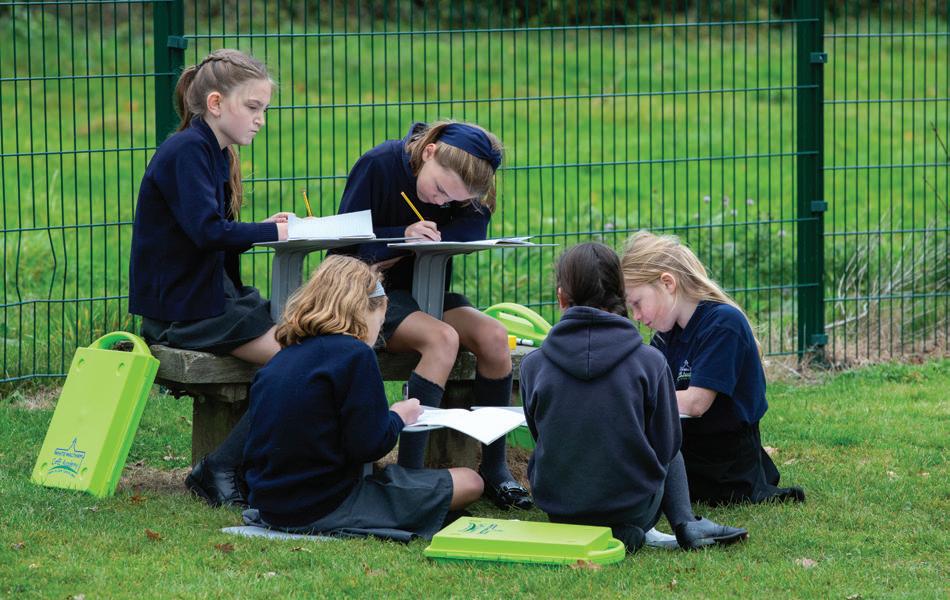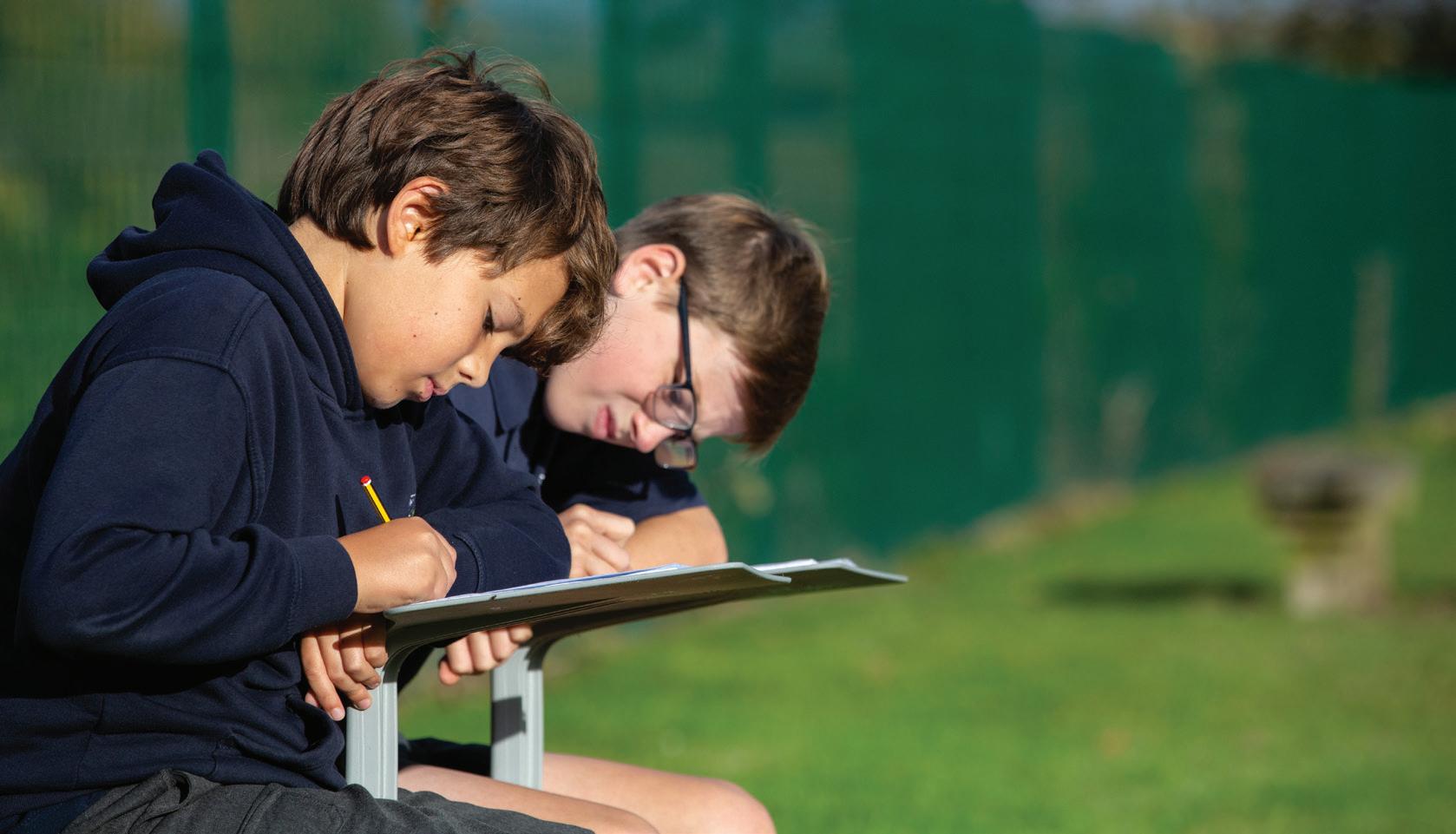
8 minute read
Peer-to-peer power
Building each other up
A multi-academy trust with three small village schools shows that you don’t have to be big, shiny and new to embrace a revolutionary approach to learning. Suzanne Kyle reports.
Nestled in the leafy Home Counties in the south of England, the three schools of the Ashley Hill Multi Academy Trust enjoy idyllic locations: Bisham C of E Academy borders the majestic River Thames and has a sixteenth-century church next door; White Waltham C of E Academy sits in a conservation area replete with historical buildings; and the Knowl Hill C of E Academy is perched moments from the village common. So far so traditional. Look inside their classrooms, however, and you’ll see half the class under direct instruction from their teacher while the other half work independently. You’ll notice children sitting at tables, standing at huge whiteboards, lying on the floor, sitting on a mat with a ZigZag table or plugged into a tablet with headphones on. Supervised they may be, but no one’s telling them what to do and they all look busy, engaged and focused.
Child empowerment It wasn’t always like this. Four years ago, the trust began to recognise the negative impact that streaming by ability was having on some pupils. The leadership team knew things needed to change and was unafraid to grasp the nettle. Isabel Cooke, CEO and Executive Principal of Ashley Hill Multi Academy Trust, explains: “Like most schools we used to stream children according to ability. The lower-ability children were given huge amounts of support and direction but we came to realise that this was leaving them disempowered. They would wait to be told what to do and lacked the independent learning skills they would need when moving from a small setting into a secondary school cohort. We also came to recognise that identifying yourself as ‘low ability’ can be really damaging to a child’s self-esteem – it can take a long time to recover from that label. “What’s also interesting is that some high-ability children were good at grammar and at getting things down on paper – skills that so-called ‘less able’ children may have found harder – but they weren’t necessarily highly skilled when it came to their imagination. Also, we saw higher-ability children who instinctively knew an answer but struggled to show their reasoning, which is something they have to be able to do to demonstrate embedded skills and knowledge. We knew we had to change.”


The leadership team worked together to design and implement a radically different approach, trialling various types of mixed ability learning to find the right combination that would give all their pupils the skills they needed. Working in mixed ability groups, the children now spend half their time under direct instruction from their teacher and the other half working independently on what the trust calls “continuous provision” tasks. These are tasks set by the teacher but completed independently in resource-rich areas of the school dedicated to different subjects. The children can choose the resources that will best help their learning and work independently or in groups depending on the task, providing peer-to-peer support to each other along the way. For maths they may choose, for example, beads, counters, Numicon, a variety of measuring devices, large wall-mounted whiteboards or tablet computers. Literacy resources include dictionaries, thesauruses, books, word maps, examples of text and access to online resources via tablet computers. The children are empowered and able to exercise autonomy while building their resilience, independence and collaboration skills.

A supportive ethos A strong Christian ethos permeates these church schools. Their motto “Encourage one another and build each other up” (taken from 1 Thessalonians 5:11) resonates strongly with continuous provision, where children of all abilities support each other with their learning. One eight-year-old boy was overheard talking to a peer who was struggling, saying: “Let me help you get started. I’ll read you the question, you tell me what to do next and then you can carry on. But I’m not giving you the answer because you need to work it out on your own.” “This was a child who may struggle in other areas but the compassion he showed just blows me away!,” says Isabel Cooke. “The children are so intuitive towards each other and so supportive. It gladdens our heart when we see things like that; it brings us such joy and it’s a wonderful demonstration of our values and ethos.”
This supportive ethos extends to the staff, too, some of whom found it difficult to switch to a culture of continuous improvement and challenge. “The leadership team is passionate about what we do,” says Isabel. “The heads of school are very visible in the classroom, supporting and encouraging, and we share the planning across the trust to lessen the load on individual teachers. It doesn’t suit everyone; some people are more comfortable sticking to what they know. We are very honest when interviewing to make sure people know that we don’t rest on our laurels. We are always looking for ways to improve.” The radical shift to 50/50 learning meant remodelling the trust’s learning environments to accommodate this new way of working, but revamping the classrooms wasn’t purely pragmatic. “Children mustn’t think you only learn sitting at a desk,” explains Isabel. “We’ve got mats for them to lie on, ZigZag tables they can use while sitting on the floor, LearningWalls with huge whiteboards they can stand at to work, group tables, standing tables and individual tables to allow children to find which way they work best. When they are writing lots of them will take a ZigZag table and sit on the floor because it’s more comfortable. Some of them, especially boys, like to lie on their stomach. What matters is that they can make a choice and take responsibility for their learning.”
Hi-tech, low-tech Technology also plays a significant role in the trust’s continuous provision. “We try to use as much technology as possible because the children find it so engaging,” says Isabel. “We’re aware that we’re competing with gaming consoles so we’ve invested in fibre optic broadband and dual tablets. Children can scan a QR code and access a video made by their teacher to explain a task. We also use technology to help children overcome barriers. We used to scribe for children who were very imaginative but found it difficult to get their ideas down on the page, but we found that they’d be waiting for an adult to help them. Now they can use headphones with microphones in, speak their text and see it flow onto the screen. We’re lucky that we have fantastic PTAs to help raise funds to buy this kit; the problem now is that it will be obsolete within five years and need replacing.”

While hi-tech is very much on the agenda, low-tech outdoor learning is also encouraged to make the most of the schools’ locations. Rather than simply taking work outside, the children are encouraged to learn about the natural world on their doorstep, observing seasonal changes, exploring bug hotels and absorbing the world around them. The recent installation of a CC20 Studio at White Waltham has provided additional classroom space that the children are making the most of. “The children love going outside and using the outdoor classroom,” enthuses Isabel. “We’d like more outdoor provision so we can really be indoor/outdoor. It’s great when the group doing their continuous provision tasks can work outside, partly because it’s good for them to be out in the fresh air and also because it’s quieter for the children working with the teacher.” While the trust is continually fine-tuning, the impact of the new approach has been clear. One child, who previously would barely pick up a pencil and always waited to be told what to do, is flying along because they are taking responsibility for their own learning. Other children are blossoming because learning has become a shared endeavour, boosted by help from their peers; solving a maths problem as a group helps them articulate their methodology because they have to explain it to other people. And others are sharing their natural compassion while helping their friends. It seems that, for the Ashley Hill schools, encouraging one another and building each other up really are more than merely some words from the Bible.


Ashley Hill specified CC20 Studio, Bloq, ZigZag and BioCases from Learniture. For more information see learniture.co.uk.
“I can see the children’s self-confidence has grown, how this approach builds their self-esteem and how they benefit, hugely, from peer-to-peer learning. We find this approach raises attainment across the spectrum of abilities. Beforehand, particularly with the least able children, there was no ‘learning mobility’ – as they progressed through the school, they would stay in the same ability groups. Now we are seeing those children make fantastic progress. I’m so behind continuous provision because it opens doors and keeps independent learning skills strong, which is great preparation for senior school. The payoff is amazing. It’s painful to start with, but it changes the children’s thinking from ‘what I can’t do’ to ‘what I can do’ and that is why it has such an impact on their outcomes.”
Laura Morel, Head of School Bisham C of E Academy









